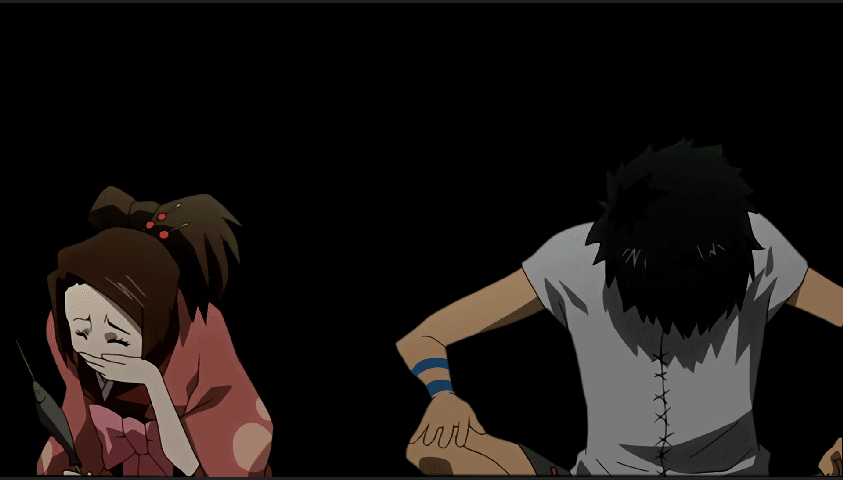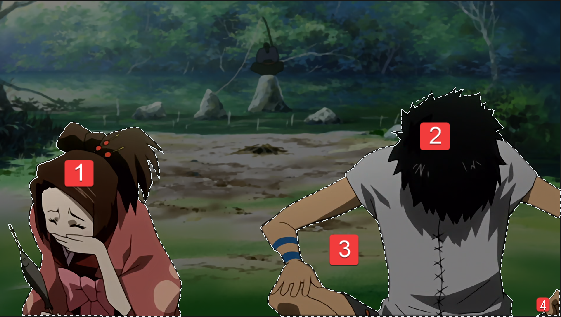
Creating a mask
Masks come in all kinds of shapes like rectangles, ellipses and freeform bézier curves. The regular shapes have their own tools in the Pan/Crop windows left toolbar. Using the Anchor Creation tool, you can create freeform bézier curves. Bézier is a type of curve, mathematically speaking. They're created by defining points (called anchors). Each anchor also has two "weights" which define how much the line to the previous point and next point should curve. Since each anchor has these weights, the resulting curve is a product of both of its anchors weights. The mathematical weights are represented by "handles" in almost all programs that use bézier curves.
To create a mask, select the event that you wish to mask and open the Pan/Crop menu. At the bottom of the Pan/Crop window, make sure to enable and select the Mask option, under Position.

Select the Anchor Creation tool  to add anchors. Clicking on an anchor lets you move it while clicking anywhere but an anchor will add a new anchor to your line. If you click the first anchor after creating at least two, the mask shape will be closed. It's still possible to edit the mask shape when it's closed.
to add anchors. Clicking on an anchor lets you move it while clicking anywhere but an anchor will add a new anchor to your line. If you click the first anchor after creating at least two, the mask shape will be closed. It's still possible to edit the mask shape when it's closed.
To delete anchors, select them with either the selection tool or the Anchor Creation tool and press delete. You may also use the Anchor Deleting tool from the toolbar to remove anchors with a single click.
from the toolbar to remove anchors with a single click.
To move your view, use the Normal Edit tool  OR hold ctrl and click n drag anywhere in the masking view (except the actual lines of the mask).
OR hold ctrl and click n drag anywhere in the masking view (except the actual lines of the mask).
To move your anchors, use the Normal Edit tool  OR hold ctrl and click n drag the anchor point.
OR hold ctrl and click n drag the anchor point.
Using the Anchor Creation tool  and dragging an anchor point without holding ctrl will enable the weights and reveal the anchors "handles". By adjusting the handles you can adjust the curving of the line between your anchors.
and dragging an anchor point without holding ctrl will enable the weights and reveal the anchors "handles". By adjusting the handles you can adjust the curving of the line between your anchors.

There's a ton of ways to mask, you can be as precise as you need and use curves as much as or as little as you want to. But if you ever want to use After Effects, it's a good idea to learn how to use bézier curves.
Vegas Pro lets you make multiple masks on a clip. Animating multiple masks is tedious, especially if you add more masks after already animating another mask. The main use of multiple masks on a single clip are negative masks. These are useful for punching holes to positive masks. For example, you've masked a character but there's a gap between their arm, hair or clothing that shows the background. You can use a negative mask to remove that part from your main mask. Depending on how large the gap showing the background is and what your new background is, it might not be necessary to remove it.
If you want to mask multiple objects, it's recommended (by me) to duplicate the clip and make an entirely new mask. Unless the other object is very simple. Or you need an effect to see both masked objects. Use your own judgement. The reason why I do not recommend masking multiple objects in the same clip is that it's hard to animate multiple masks in Vegas Pro.
Animating masks
Enabling the mask automatically enables keyframing of the mask. This works the same way animating the position does.
There's multiple methods to animate a mask. After masking the first frame, you can either move the points of your existing mask to their new locations, or right click > reset mask to start with a clean slate. This resetting functionality is unique to Vegas Pro, and doesn't work in, for example, After Effects. Which is why you should learn to use the least amount of anchors possible and how to efficiently use the curves part of bézier curves. That is, if you ever plan to use After Effects. If not, go wild and use any number of points per keyframe. It can be a very efficient and fast way of masking to reset on every frame. This is just a warning for prospective AE users to not get used to the luxury of resetting masks.
If you're working with anime that only moves every other frame (like most anime does), you will notice that creating new masks only on those new frames will lead to Vegas animating the shape between those two keyframes. To stop this, select your keyframes and right click > hold. This will turn the keyframes red and stop Vegas from interpolating (animating between keyframes).
Mask settings
On the left of the Pan/Crop window, you'll see the different settings that you can apply to your mask:
- Apply to FX : When activated, this option will make it so your mask only apply to the effects of the event, not the content.
- Mode : Positive is the default, making anything inside the mask visible. Negative is the opposite. Disabled will deactivate the mask.
- Opacity : Reduces the masks influence on the content and other masks. A bit counter-intuitive, especially if there's only one mask on a clip.
- Feather : Blurs the edges of the mask. Good for blending the masked object into a new background and reducing "chatter" (or discoloration) of the edges.

Tips

- Depending on the complexity of the object you want to mask, you may want to use multiple masks. In the image above, there's a total of 4 masks, with different settings. Mask number 3 is negative.
- It's very easy to lose track of your mask in the Pan/Crop window by zooming and / or panning around. Deselection is also common. To continue your mask, try double-clicking on the last anchor point with the Normal Edit tool
 . If nothing else works, try Ctrl + Z until you see the anchor points again. Remember that either ctrl + shift + Z or ctrl + Y lets you re-do anything you undo.
. If nothing else works, try Ctrl + Z until you see the anchor points again. Remember that either ctrl + shift + Z or ctrl + Y lets you re-do anything you undo.